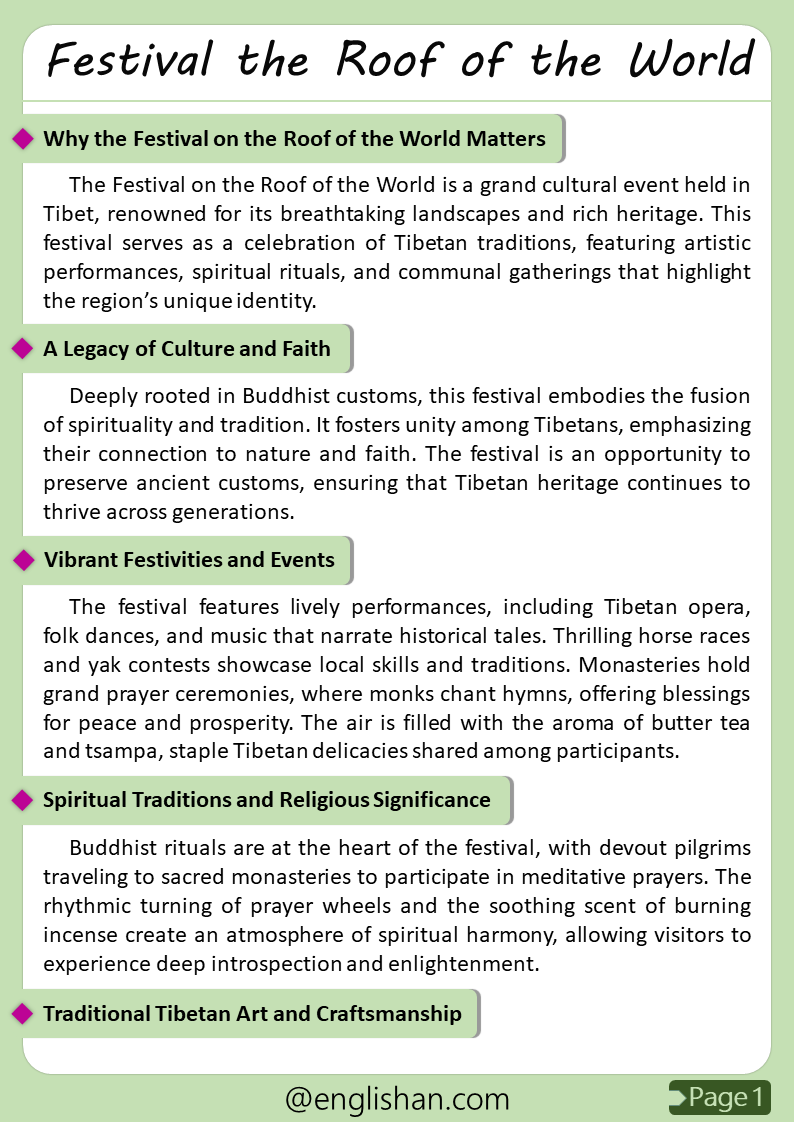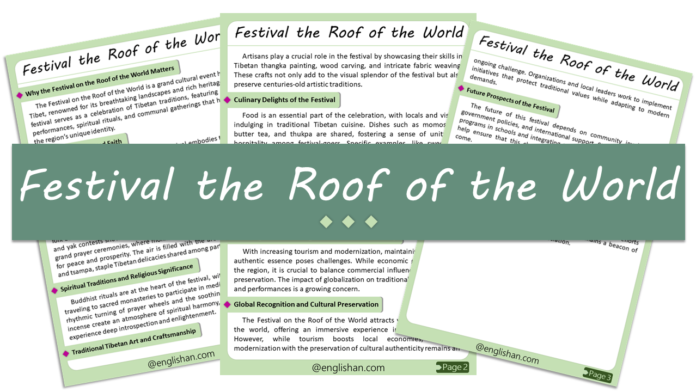Contents
When writing about the Festival on the Roof of the World, it’s important to understand how this event celebrates culture, nature, and unity in Pakistan’s northern mountains. This essay on the Festival on the Roof of the World explains its location in Gilgit-Baltistan, the traditional music, polo games, local food, and the values of peace and togetherness it shares. It’s written in 500 words to help students with homework or exams. You can download this festival essay as a free PDF or image to study or print.
10 Lines Festival on the Roof of the World Essay for Class 2 to Class 5
- The Festival on the Roof of the World is held in the Gilgit-Baltistan region of Pakistan.
- It is called the “Roof of the World” because it takes place in the high mountains.
- This festival celebrates the unique culture of mountain people.
- Local music, dances, and colorful clothes are an important part of the event.
- People from many areas join together to enjoy the celebration.
- Polo matches and traditional games are played during the festival.
- Artists perform folk songs in local languages.
- Delicious traditional food is shared among families and tourists.
- The festival teaches us about peace, culture, and togetherness.
- It is a joyful event that shows the beauty of Pakistan’s mountains.

250 Words Essay on Festival on the Roof of the World for Middle School
The “Festival on the Roof of the World” is a special cultural event held in the beautiful region of Gilgit-Baltistan in northern Pakistan. This area is often called the “Roof of the World” because of its high mountains and stunning natural beauty.
The festival celebrates the rich culture, traditions, and lifestyle of the local people. It brings together communities, tourists, and artists to enjoy traditional music, dances, crafts, and food. Men and women wear colorful clothes, and local performers play folk instruments and sing songs in regional languages.
One of the most exciting parts of the festival is the polo match, a popular sport in the region. People also take part in tug-of-war, traditional wrestling, and other local games. Stalls with handmade items, artwork, and local food attract visitors and help support local artists and families.
The Festival on the Roof of the World is not just about fun and entertainment. It also promotes peace, unity, and the beauty of cultural heritage. It helps young people learn about their roots and traditions in a joyful way.
This festival teaches us the value of togetherness and respect for diversity. It also helps promote tourism in Pakistan by showing the world the culture and kindness of its mountain people.
500 Words Festival on the Roof of the World Essay for Upper Primary and Lower Secondary
Why the Festival on the Roof of the World Matters
The Festival on the Roof of the World is a grand cultural event held in Tibet, renowned for its breathtaking landscapes and rich heritage. This festival serves as a celebration of Tibetan traditions, featuring artistic performances, spiritual rituals, and communal gatherings that highlight the region’s unique identity.
A Legacy of Culture and Faith
Deeply rooted in Buddhist customs, this festival embodies the fusion of spirituality and tradition. It fosters unity among Tibetans, emphasizing their connection to nature and faith. The festival is an opportunity to preserve ancient customs, ensuring that Tibetan heritage continues to thrive across generations.
Vibrant Festivities and Events
The festival features lively performances, including Tibetan opera, folk dances, and music that narrate historical tales. Thrilling horse races and yak contests showcase local skills and traditions. Monasteries hold grand prayer ceremonies, where monks chant hymns, offering blessings for peace and prosperity. The air is filled with the aroma of butter tea and tsampa, staple Tibetan delicacies shared among participants.
Spiritual Traditions and Religious Significance
Buddhist rituals are at the heart of the festival, with devout pilgrims traveling to sacred monasteries to participate in meditative prayers. The rhythmic turning of prayer wheels and the soothing scent of burning incense create an atmosphere of spiritual harmony, allowing visitors to experience deep introspection and enlightenment.
Traditional Tibetan Art and Craftsmanship
Artisans play a crucial role in the festival by showcasing their skills in Tibetan thangka painting, wood carving, and intricate fabric weaving. These crafts not only add to the visual splendor of the festival but also preserve centuries-old artistic traditions.
Culinary Delights of the Festival
Food is an essential part of the celebration, with locals and visitors indulging in traditional Tibetan cuisine. Dishes such as momos, yak butter tea, and thukpa are shared, fostering a sense of unity and hospitality among festival-goers. Specific examples, like sweet rice (dresi) and yak cheese, further highlight Tibet’s rich culinary traditions.
Influence on Tibetan Identity and Global Awareness
The festival strengthens Tibetan cultural identity while also raising global awareness about its traditions. International visitors gain insight into Tibet’s rich heritage, fostering cultural appreciation and dialogue. Efforts by Tibetan communities worldwide help keep the spirit of the festival alive beyond regional boundaries.
Challenges in Preserving the Festival’s Authenticity
With increasing tourism and modernization, maintaining the festival’s authentic essence poses challenges. While economic growth benefits the region, it is crucial to balance commercial influences with cultural preservation. The impact of globalization on traditional attire, language, and performances is a growing concern.
Global Recognition and Cultural Preservation
The Festival on the Roof of the World attracts visitors from around the world, offering an immersive experience into Tibetan culture. However, while tourism boosts local economies, balancing modernization with the preservation of cultural authenticity remains an ongoing challenge. Organizations and local leaders work to implement initiatives that protect traditional values while adapting to modern demands.
Future Prospects of the Festival
The future of this festival depends on community involvement, government policies, and international support. Strengthening cultural programs in schools and integrating sustainable tourism initiatives can help ensure that this cherished tradition thrives for generations to come.
Conclusion
Beyond being a mere celebration, this festival is a testament to Tibetan resilience and cultural richness. It unites communities, honors spiritual traditions, and provides a meaningful experience for all who attend. For those seeking a deeper understanding of Tibetan life, this festival serves as a profound window into its heritage. As efforts continue to preserve its authenticity, this festival remains a beacon of Tibetan identity and global cultural appreciation.

Difficult Words Used in 500 Festival on the Roof of the World Essay
| Word | Meaning |
|---|---|
| Heritage | Traditions and culture passed through generations |
| Prosperity | The state of being successful and thriving |
| Serenity | The state of being calm and peaceful |
| Pilgrims | People traveling to a sacred place for religious reasons |
| Artisans | Skilled craft workers |
| Rituals | Religious or traditional ceremonies |
| Introspection | The act of examining one’s own thoughts and feelings |
| Authenticity | The quality of being genuine and true to its origins |
| Resilience | The ability to recover from challenges or difficulties |
| Solidarity | Unity and mutual support within a group |
| Conservation | Protection and preservation of the environment |
| Cham Dance | A sacred masked dance performed by Tibetan monks |
Festival on the Roof of the World Essay PDF
You May Also Like
